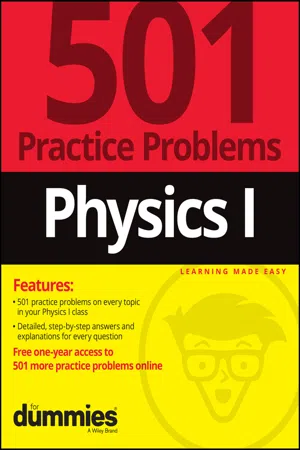Physics
Angular Acceleration
Angular acceleration refers to the rate of change of angular velocity over time. It measures how quickly an object's rotational speed is changing. In mathematical terms, it is the second derivative of the angular displacement with respect to time. Angular acceleration is a crucial concept in understanding rotational motion and is measured in units of radians per second squared (rad/s^2).
Written by Perlego with AI-assistance
Related key terms
1 of 5
10 Key excerpts on "Angular Acceleration"
- eBook - PDF
- John D. Cutnell, Kenneth W. Johnson, David Young, Shane Stadler(Authors)
- 2015(Publication Date)
- Wiley(Publisher)
Your extended thumb points along the axis in the direction of the angular velocity vector. No part of the rotating object moves in the direction of the angular velocity vector. Angular Acceleration arises when the angular velocity changes, and the acceleration vector also points along the axis of rotation. The acceleration vector has the same direction as the change in the angular velocity. That is, when the magnitude of the angular velocity (which is the angular speed) is increasing, the Angular Acceleration vector points in the same direction as the angular velocity. Conversely, when the magnitude of the angular velocity is decreasing, the Angular Acceleration vector points in the direction opposite to the angular velocity. Right hand Right hand v v Figure 8.15 The angular velocity vector B v of a rotating object points along the axis of rotation. The direction along the axis depends on the sense of the rotation and can be determined with the aid of a right-hand rule (see the text). CONCEPT SUMMARY 8.1 Rotational Motion and Angular Displacement When a rigid body rotates about a fixed axis, the angular displacement is the angle swept out by a line passing through any point on the body and intersecting the axis of rotation perpendicularly. By convention, the angular displacement is positive if it is counterclockwise and negative if it is clockwise. The radian (rad) is the SI unit of angular displacement. The angle u in radians is defined in Equa- tion 8.1 as the circular arc of length s traveled by a point on the rotating body divided by the radial distance r of the point from the axis. 8.2 Angular Velocity and Angular Acceleration The average angular velocity v is the angular dis- placement Du divided by the elapsed time Dt, according to Equation 8.2. As Dt approaches zero, the average angular velocity becomes equal to the instantaneous angular velocity v. The magnitude of the instantaneous angular velocity is called the instantaneous angular speed. - eBook - PDF
- William Moebs, Samuel J. Ling, Jeff Sanny(Authors)
- 2016(Publication Date)
- Openstax(Publisher)
• The angular velocity of a rotating body about a fixed axis is defined as ω(rad/s) , the rotational rate of the body in radians per second. The instantaneous angular velocity of a rotating body ω = lim Δt → 0 Δω Δt = dθ dt is the derivative 530 Chapter 10 | Fixed-Axis Rotation This OpenStax book is available for free at http://cnx.org/content/col12031/1.5 with respect to time of the angular position θ , found by taking the limit Δt → 0 in the average angular velocity ω – = Δθ Δt . The angular velocity relates v t to the tangential speed of a point on the rotating body through the relation v t = rω , where r is the radius to the point and v t is the tangential speed at the given point. • The angular velocity ω → is found using the right-hand rule. If the fingers curl in the direction of rotation about a fixed axis, the thumb points in the direction of ω → (see Figure 10.5). • If the system’s angular velocity is not constant, then the system has an Angular Acceleration. The average Angular Acceleration over a given time interval is the change in angular velocity over this time interval, α – = Δω Δt . The instantaneous Angular Acceleration is the time derivative of angular velocity, α = lim Δt → 0 Δω Δt = dω dt . The Angular Acceleration α → is found by locating the angular velocity. If a rotation rate of a rotating body is decreasing, the Angular Acceleration is in the opposite direction to ω → . If the rotation rate is increasing, the Angular Acceleration is in the same direction as ω → . • The tangential acceleration of a point at a radius from the axis of rotation is the Angular Acceleration times the radius to the point. 10.2 Rotation with Constant Angular Acceleration • The kinematics of rotational motion describes the relationships among rotation angle (angular position), angular velocity, Angular Acceleration, and time. • For a constant Angular Acceleration, the angular velocity varies linearly. - eBook - ePub
- William Bolton(Author)
- 2012(Publication Date)
- Routledge(Publisher)
The instantaneous angular velocity ω is the change in angular displacement with time when the time interval tends to zero. It can be expressed as:
3 Angular AccelerationThe average Angular Acceleration over some time interval is the change in angular velocity during that time divided by the time:[20] [21] The unit is rad/s2 . The instantaneous Angular Acceleration a is the change in angular velocity with time when the time interval tends to zero. It can be expressed as:[22] 4.4.1 Motion with constant Angular AccelerationFor a body rotating with a constant Angular Acceleration α, when the angular velocity changes uniformly from ω0 to co in time t, as in Figure 4.19 , equation [21 ] gives:Figure 4.19 Uniformly accelerated motionand hence:ω = ω0 + at [23] The average angular velocity during this time is ½(ω + ω0 ) and thus if the angular displacement during the time is θ:Substituting for co using equation [23 ]:Hence:θ = ω0 t + ½at2 [24] Squaring equation [23 ] gives:Hence, using equation [24 ]:[25] ExampleAn object which was rotating with an angular velocity of 4 rad/s is uniformly accelerated at 2 rad/s. What will be the angular velocity after 3 s?Using equation [23 ]:ω = ω0 + at = 4 + 2 × 3 = 10 rad/sExampleThe blades of a fan are uniformly accelerated and increase in frequency of rotation from 500 to 700 rev/s in 3.0 s. What is the Angular Acceleration?Since ω = 2πf, equation [23 ] gives:2π × 700 = 2π × 500 + a × 3.0Hence a = 419 rad/s2 .ExampleA flywheel, starting from rest, is uniformly accelerated from rest and rotates through 5 revolutions in 8 s. What is the Angular Acceleration?The angular displacement in 8 s is 2π × 5 rad. Hence, using equation [24 ], i.e. θ = ω0 t + ½at2 :2π × 5 = 0 + ½a × 82Hence the Angular Acceleration is 0.98 rad/s2 .Revision13 A flywheel rotating at 3.5 rev/s is accelerated uniformly for 4 s until it is rotating at 9 rev/s. Determine the Angular Acceleration and the number of revolutions made by the flywheel in the 4 s. - eBook - ePub
Doing Physics with Scientific Notebook
A Problem Solving Approach
- Joseph Gallant(Author)
- 2012(Publication Date)
- Wiley(Publisher)
Evaluate Numerically to find the number of times the record turns while it’s slowing down.The record turns about 2.8 times while it’s slowing down.When the Angular Acceleration is not constant, you must use calculus to describe the object’s rotational motion. The angular velocity is the rate of change of the angular displacement.(7.9)If you know the angular position as a function of time, you can calculate the angular speed.The Angular Acceleration is the rate of change of angular speed.(7.10)If you know the angular speed as a function of time, you can calculate the Angular Acceleration. From these definitions we can derive four basic equations which describe the angular position and speed of objects rotating with a varying acceleration.(7.11a)(7.11b)(7.11c)(7.11d)For varying Angular Acceleration, the average angular velocity does not equal the arithmetic average of the initial and final angular velocities.The Compact Disk
The rotational motion of a CD is an excellent example of nonuniform rotational motion with a time-dependent acceleration. To read the information on a record, a needle starts at the outer edge and follows a single spiral track while the disk rotates at a constant angular speed. To read the information on a CD, a laser starts at the inner radius and follows a single spiral track while the disk rotates at a decreasing angular speed. This ensures the data-read rate, which is proportional to the linear speed, is constant. [31]The data on a typical CD is stored between R0 = 2.3 cm and Rf = 5.8 cm, and the spacing between tracks is Δr = 1.6 μm/rev. We can use Evaluate Numerically - Raymond Serway, John Jewett(Authors)
- 2018(Publication Date)
- Cengage Learning EMEA(Publisher)
Equation 10.10 shows that the tangential speed of a point on the rotat- ing object increases as one moves outward from the center of rotation, as we would intuitively expect. For example, the outer end of a swinging golf club moves much faster than a point near the handle. We can relate the Angular Acceleration of the rotating rigid object to the tangen- tial acceleration of the point P by taking the time derivative of v in Equation 10.10: a t 5 dv dt 5 r dv dt a t 5 r a (10.11) That is, the tangential component of the translational acceleration of a point on a rotating rigid object equals the point’s perpendicular distance from the axis of rotation multiplied by the Angular Acceleration. In Section 4.4, we found that a point moving in a circular path undergoes a radial acceleration a r directed toward the center of rotation and whose magnitude is that of the centripetal acceleration v 2 / r (Fig. 10.5). Because v 5 rv for a point P on a rotating object, we can express the centripetal acceleration at that point in terms of angular speed as we did for a particle moving in a circular path in Equation 4.25: a c 5 v 2 r 5 r v 2 (10.12) The total acceleration vector at the point is a S 5 a S t 1 a S r , where the magnitude of a S r is the centripetal acceleration a c . Because a S is a vector having a radial and a tan- gential component, the magnitude of a S at the point P on the rotating rigid object is a 5 Ïa t 2 1 a r 2 5 Ïr 2 a 2 1 r 2 v 4 5 r Ïa 2 1 v 4 (10.13) Q UICK QUIZ 10.3 Ethan and Rebecca are riding on a merry-go-round. Ethan rides on a horse at the outer rim of the circular platform, twice as far from the center of the circular platform as Rebecca, who rides on an inner horse.- eBook - PDF
- Raymond Serway, Chris Vuille(Authors)
- 2017(Publication Date)
- Cengage Learning EMEA(Publisher)
That principle is the equivalent of Newton’s first law. Further, the Angular Acceleration of an object is proportional to the net torque acting on it, which is the analog of Newton’s second law. A net torque acting on an object causes a change in its rotational energy. Finally, torques applied to an object through a given time interval can change the object’s angular momentum. In the absence of external torques, angular momentum is conserved, a property that explains some of the mysterious and formidable properties of pulsars, rem- nants of supernova explosions that rotate at equatorial speeds approaching that of light. 8.1 Torque Forces cause accelerations; torques cause Angular Accelerations. There is a definite relationship, however, between the two concepts. Figure 8.1 depicts an overhead view of a door hinged at point O. From this viewpoint, the door is free to rotate around an axis perpendicular to the page and passing through O. If a force F S is applied to the door, there are three factors that determine the effectiveness of the force in opening the door: the magnitude of the force, the position of application of the force, and the angle at which it is applied. For simplicity, we restrict our discussion to position and force vectors lying in a plane. When the applied force F S is perpendicular to the outer edge of the door, as in Figure 8.1, the door rotates counterclockwise with constant angular accelera- tion. The same perpendicular force applied at a point nearer the hinge results in a smaller Angular Acceleration. In general, a larger radial distance r between the applied force and the axis of rotation results in a larger Angular Acceleration. Simi- larly, a larger applied force will also result in a larger Angular Acceleration. - Paul Grimshaw, Neil Fowler, Adrian Lees, Adrian Burden(Authors)
- 2007(Publication Date)
- Routledge(Publisher)
direction). Usually, we are normally concerned with rotation about one axis of rotation and it is applicable therefore to refer to angular momentum about a single origin or a single axis of rotation. In this manner we can consider it as a scalar quantity where we refer to its direction as either positive (anti-clockwise rotation) or negative (clockwise rotation). In addition, it is worth repeating that the total angular momentum of a body about any axis of rotation is made up by adding all the angular momenta of the various parts or segments of the body which are rotating about that axis. Within biomechanics this has important implications for understanding human movement and in more complex analyses the study of angular momenta about multiple axes of rotation is required.As we have seen, a net torque (that is not zero) that acts on an object will cause an Angular Acceleration of the object in the direction of the net torque. The amount of net external torque will equal the rate of change of angular momentum (i.e., from the angular analog of Newton’s second law).The change in angular momentum of an object can be determined by examining the initial and final angular momentum possessed by the object: Change in angular momentum = Angular momentum (final) − Angular momentum (initial) Thus we can now include this in the equation for torque: Mathematically this can be expressed as: Rearranging this equation produces the following: T(net) × (t2 − t1 ) = L(f) − L(i) This can now be expressed as the equation for angular impulse: This equation has important implications for the effective execution of rotational movements with human motion.Application
Considering the diver inFig. C2.3- No longer available |Learn more
Physics for Scientists and Engineers
Foundations and Connections, Extended Version with Modern Physics
- Debora Katz(Author)
- 2016(Publication Date)
- Cengage Learning EMEA(Publisher)
Find the magnitude of the Earth’s angular displacement Du, angular speed v, and angular ac- celeration a during that time interval. The Earth’s rotation is very nearly uniform. INTERPRET and ANTICIPATE Every 24 hours, the Earth completes one revolution. We expect to find numerical answers in the form Du 5 rad, v 5 rad / s , and a 5 rad / s 2 . SOLVE The uniform rotation of the Earth means that in half its pe- riod it completes half a revolution. Du 5 1 2 rev 5 1 2 12p rad 2 5 p rad The Earth’s angular speed is constant. The instantaneous angular speed (Eq. 12.4) equals the average angular speed (Eq. 12.3). v 5 v av 5 Du Dt 5 p rad 12 h # 13600 s / 1 h 2 (12.3) v 5 p rad 4.3 3 10 4 s 5 7.3 3 10 25 rad / s The Earth’s constant angular speed means that its Angular Acceleration is zero. a 5 0 CHECK and THINK Uniform rotation makes this example mathematically simple. Solving this example gives us a chance to develop our intuition for angular speed: Once-a-day rotation corresponds to v 5 7.3 3 10 25 rad / s. x i A. y v i W Charlotte’s initial velocity X i z Perspective view y x x W Y i Jim’s angular velocity is along z. Jim at X i B. x i x f y x X f z y x v f W X i D W Y f W Jim at X f Charlotte speeds up, so a is in same direction as v. W W a W Jim’s rotation speeds up, so D is in same direction as Y. W W FIGURE 12.13 A. An analogy between translational velocity and angular velocity. B. An analogy between translational acceleration and Angular Acceleration. In both parts, Jim’s situation is shown in perspective with the z axis extending from upper right to lower left. Copyright 2017 Cengage Learning. All Rights Reserved. May not be copied, scanned, or duplicated, in whole or in part. WCN 02-300 338 CHAPTER 12 Rotation I: Kinematics and Dynamics 12-3 Special Case of Constant Angular Acceleration In one-dimensional translational kinematics (Chapter 2), we considered the special case in which a particle moves with constant acceleration. - (Author)
- 2022(Publication Date)
- For Dummies(Publisher)
The minus sign indicates that this acceleration is in the direction opposite the direction of the ini-tial velocity. You accelerate for t 2 6 . seconds. Plug these quantities into the equation for angular displacement to find i i m s m s rad/ s t t v r t t 1 2 1 2 22 0 37 2 6 1 2 7 3 2 2 2 2 / . . . ( . 6 130 2 s rad ) 196. 0.19 rad/s Your Angular Acceleration is a r where a 3 4 . meters per second per second is your tangential acceleration and r 25 meters is the radius of the curved part of the track. Angular velocity is related to Angular Acceleration by t where f i is your change in angular speed and t 1 4 . seconds is the time over which you acceler-ate. For this problem, the initial speed is i 0 radians per second. Combining these two equations and plugging in the known quantities gives t a r t a r t f i f m s m s rad/s 3 4 25 1 4 0 19 2 . / . . 236 PART 2 The Answers ANSWERS 101–200 197. 0.015 m/s 2 First, convert the given quantities to meters and seconds. The time it takes to complete the turn is t 12 60 1 720 min s min s The radius of the turn is r 0 50 1609 1 804 5 . . mi m mi m The angular speed of the boat is t where radians because there are radians in 180 degrees. Express the centripetal acceleration in terms of the angular speed using v r and a v r 2 . Combining these two equations and the equation above for angular speed gives a v r r r r t r 2 2 2 2 ( ) Insert the known quantities: a t r 2 2 2 720 804 5 0 015 rad s m m/s . . 198. 20 m/s 2 The tangential speed of the tip of the lasso is v r where 3 8 . radians per second is the angular speed and r 1 4 . meters is the radial distance from the center of the circle (that is, your hand) to the tip of the lasso. The centripetal acceleration is a v r r r r 2 2 2 ( ) CHAPTER 16 Answers 237 ANSWERS 101–200 Plug in the known quantities to find a r 2 2 2 3 8 1 4 20 ( . / ) . rad s m m/s 199. 0.32 m The maximum centripetal acceleration is a 3 8 .- eBook - PDF
- Raymond Serway, Chris Vuille(Authors)
- 2017(Publication Date)
- Cengage Learning EMEA(Publisher)
Figure 7.25 Kepler’s second law. Sun D C A B S S 3. The square of the orbital period of a planet is propor- r- r tional to the cube of the average distance from the planet to the Sun: T 2 5 a 4p 2 GM S S b r 3 Kepler’s third law. [7.24] The third law can be applied to any large body and its sys- tem of satellites by replacing the Sun’s mass with the body’s mass. In particular, it can be used to determine the mass of the central body once the average distance to a satellite and its period are known. 7.2 Rotational Motion Under Constant Angular Acceleration If an object undergoes rotational motion about a fixed axis under a constant Angular Acceleration a, its motion can be described with the following set of equations: v 5 v i 1 at [7.7] Du 5 v i t 1 1 2 at 2 [7.8] v 2 5 v i 2 1 2a Du [7.9] Problems are solved as in one-dimensional kinematics. 7.3 Tangential Velocity, Tangential Acceleration, and Centripetal Acceleration When an object rotates about a fixed axis, the angular velocity and Angular Acceleration are related to the tangential velocity and tangential acceleration through the relationships v t 5 r v [7.10] and a t 5 r a [7.11] Any object moving in a circular path has an acceleration directed toward the center of the circular path, called a centripetal acceleration. Its magnitude is given by a c 5 v 2 r 5 r v 2 [7.13, 7.17] Any object moving in a circular path must have a net force exerted on it that is directed toward the center of the path. Some examples of forces that cause centripetal acceleration are the force of gravity (as in the motion of a satellite) and the force of tension in a string. 7.4 Newton’s Second Law for Uniform Circular Motion The second law for uniform circular motion involves forces that are directed either towards the center of a circle or away from it.
Index pages curate the most relevant extracts from our library of academic textbooks. They’ve been created using an in-house natural language model (NLM), each adding context and meaning to key research topics.









